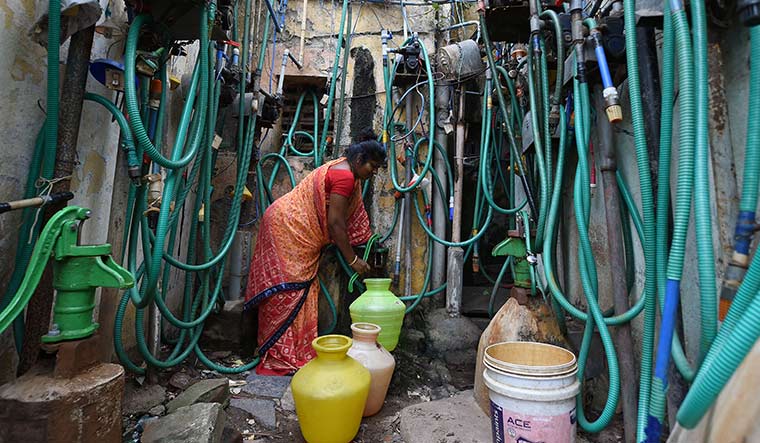ON THE NIGHT of June 15, Mohan, a resident of Shankar Nagar in south Chennai, walked into the motor room of his two-storey apartment. He was there, as usual, to pump water to his house. As he reached for the motor, his neighbour stopped him and an argument ensued. When Mohan’s wife, Subashini, 28, came out hearing the argument, Aathimoolam Ramakrishnan, one of the other neighbours, knifed her in the neck. Ramakrishnan, driver of Tamil Nadu assembly Speaker P. Dhanapal, has been arrested. Subashini is recovering at a Chennai hospital.
Elsewhere, in central Chennai, 23-year-old Shanthi Ramasamy (name changed) had to wait for at least an hour with unbearable labour pain as the hospital was expecting a water tanker. “How can I trust this government?” she asked, cradling her baby girl after a delayed birth. “At home we have a severe water crisis and here, too, I had to wait to deliver my baby.”
Subashini and Shanthi are just two of the many people who have faced the brunt of Chennai’s worst water crisis in the past three decades. The city has had almost no rain in more than 200 days.
Swathes of parched land, long lines of empty pots and speeding water tankers now define Chennai. With all four reservoirs that supply water to Chennai going dry and groundwater levels plummeting, the city’s IT firms have cut down operations and asked employees to work from home.
“It has been days since I have washed my clothes,” said Vignesh Ramalingam, a bachelor who lives in Triplicane and works at TIDEL IT park. “I get only two buckets of water a day.” Most of his roommates, who were looking for high-profile jobs, have left Chennai for their hometowns. “I do not know when my friends will come back,” he added. “Even I want to go back home (to Vellore). It is becoming more difficult day by day.”
The IT corridor has at least 650 companies and 150 high-rise buildings that employ about 3.2 lakh people and house more than 1.5 lakh residents. This area alone needs 32 million litres of water every day.
A little away, the small restaurants at Pantheon Road in Egmore have downed their shutters. “I cannot pay Rs3,000 every three days for a tanker. I get only 20 customers a day,” said Kumaran Rajasekaran, 43, who has not done business for more than week. “I do not know how to make money now.”
Chennai, which usually needs 1,300 million litres of water every day, now has to manage with 525 MLD. The piped water supply is not even 10 per cent of what it was in November, and the waiting period for a tanker—either 6,000 litres for Rs600 or 9,000 litres for Rs900—is at least 20 days. “It is like a mafia,” said Sathya Narayana, a resident of Ashok Nagar. “Every time I book a water tanker online, I get it only after 20 days. And I am forced to pay at least Rs250 to the water tanker driver.” The private tankers are more expensive, costing about Rs7,500 for 24,000 litres of water. “This water they supply is very dirty,” he added.
The residents of Sunflower Apartments in Ashok Nagar spent 02 lakh to dig an extra, 750-foot bore-well. But they found little water. “We get only three buckets of water from it every day,” said resident Subramanian Venkatachalam. With the groundwater level in the city dipping below 600 feet, bore-well installation charges are up 150 per cent. The water level in the four reservoirs—Chembarambakkam, Cholavaram, Red Hills and Poondi—is at 1.3 per cent of the total capacity. It was the Chembarambakkam reservoir that overflowed in 2015, flooding the city.
Chennai now depends on three mega desalination plants, with a combined capacity of 180 MLD. These are working round the clock to water the city’s residents. Apart from this, there is the new Veeranam pipeline that brings 90 MLD from near the delta region, at least 235km from the city. Moreover, water from the quarries outside Chennai is being purified and supplied through tankers to at least 5 per cent of 8.5 lakh households that have water connections.
Notably, Chief Minister Edappadi K. Palaniswami said the issue was “being blown up by the media”. He welcomed the offer made by his Kerala counterpart Pinarayi Vijayan to supply 20,000 million litres of water, but added that, “It would be helpful if that amount is delivered every day and not as a one-time delivery.”
He also said that, against the due share of 12tmcft water from the Krishna in Andhra Pradesh, only 2tmcft was released, owing to shortage there as well.
Though people are feeling the heat now, Chennai’s water woes have been building up ever since the city began expanding, three decades ago. The region has lost several lakes and ponds because of encroachment, and the remaining ones have shrunk. “The minister says the government had spent at least 030,000 crore for water schemes. But what is the use?” asked professor S. Janakarajan of the Madras Institute of Developmental Studies. “There should be an ecological balance. Now we are drawing water from the giant bore-wells outside Chennai. Those will also dry. And then what is the source?”
As people are battling to manage the water crisis, politicians have been passing the buck. While the ruling AIADMK has conducted yagnas in temples to appease the rain gods, the opposition DMK has hit the streets with empty pots. “When people are suffering, the AIADMK government is going to God to ask for water. It means they cannot solve the issue,” DMK president M.K. Stalin said during a protest in Chennai.
On the other hand, the AIADMK’s prime ally, the BJP, has blamed the DMK for the water shortage. State president Tamilisai Soundrarajan said the DMK had allowed encroachment of water bodies over the years, leading to the crisis.
Expectedly, the political blame game continues. As do the woes of the common Chennaiite.


